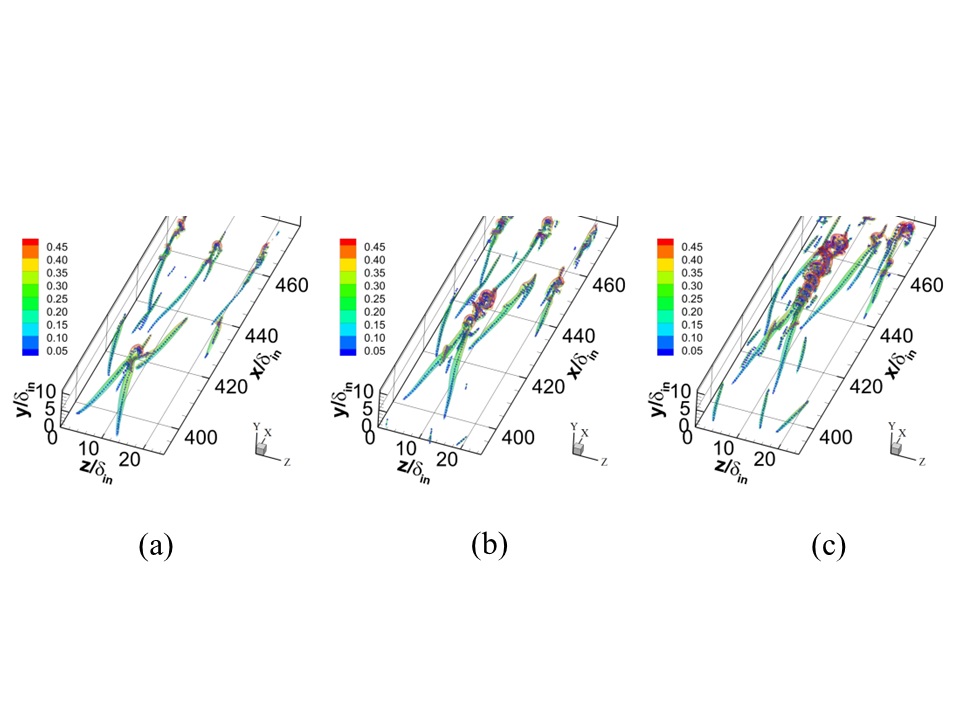Studies on nonlinear vortex dynamics in the later-stage of laminar-turbulent transition in compressible boundary layers
JAXA Supercomputer System Annual Report April 2019-March 2020
Report Number: R19EACA13
Subject Category: JSS2 Inter-University Research
- Responsible Representative: Kazuo Matsuura, Associate Professor, Ehime University, Graduate School of Science and Engineering
- Contact Information: Kazuo Matsuura(matsuura.kazuo.mm@ehime-u.ac.jp)
- Members: Kazuo Matsuura
Abstract
In hypersonic transitional flows, there are many complicated factors such as density fluctuation and temperature fluctuation due to the co-existence of the region slower than the speed of sound and the region faster than the speed of sound inside the boundary layer. Detailed investigations into the vortex dynamics occurring inside the boundary layers are expected. In this study, we aim to clarify the nonlinear vortex dynamics especially in the late-stage by conducting direct numerical simulations of laminar-turbulent transition in compressible boundary layers observed in hypersonic flows. Also, we develop a mathematical methodology to directly introduce vortices responsible for the late stage to the boundary layers, and its computational methods.
Reference URL
N/A
Reasons and benefits of using JAXA Supercomputer System
For the investigation of boundary layer transition of hypersonic flows, numerical simulation is a central tool because measurement is difficult due to the existence of acoustical disturbance in a wind tunnel. Because boundary layer transition is susceptible to disturbance, and in addition transition is hard to occur due to strong compressibility, powerful supercomputers that enable high-accuracy large-scale computation are necessary to get results in a short time period.
Achievements of the Year
A new method that evaluates dominant local dynamics by skeletonization, mathematical term decomposition and the re-combination of a reduced number of dominant terms around the skeleton points is proposed to clarify the dynamics of hairpin vortices generated during the boundary-layer transition under free-stream turbulence (Fig.1). The present method enables the automatic finding and categorization of the variations of the sets of dominant terms that govern local dynamics during the evolution of hairpin vortices.

Fig.1: Time evolution of hairpin and satellite vortices represented by the skelton points (blue points) and the transparent iso-surfaces (Free-Stream Turbulence Level=0.5%). The color on the iso-surfaces is Mach number. (a) t=258.0δin/u∞ (b) t=281.5δin/u∞ (c) t=305.0δin/u∞
Publications
- Peer-reviewed papers
Kazuo Matsuura, "Algorithmic Exploration of Dominant Terms Around Hairpin Vortices Generated During Boundary-Layer Transition Under Free-Stream Turbulence," Int. J. Environ. Impacts, Vol. 3, No. 1 (2020).
- Non peer-reviewed papers
Kazuo Matsuura, Yasuhide Fukumoto, A Study on Clustering of Hairpin Vortices in Transitional Boundary-Layer, 24th Japan Society of Fluid Mechanics, Chushikoku-Kyushu Branch, pp. 1-2 (2019).
Usage of JSS2
Computational Information
- Process Parallelization Methods: MPI
- Thread Parallelization Methods: Automatic Parallelization
- Number of Processes: 16 - 64
- Elapsed Time per Case: 168 Hour(s)
Resources Used
Fraction of Usage in Total Resources*1(%): 0.00
Details
Please refer to System Configuration of JSS2 for the system configuration and major specifications of JSS2.
| System Name | Amount of Core Time(core x hours) | Fraction of Usage*2(%) |
|---|---|---|
| SORA-MA | 7,281.63 | 0.00 |
| SORA-PP | 0.00 | 0.00 |
| SORA-LM | 0.00 | 0.00 |
| SORA-TPP | 0.00 | 0.00 |
| File System Name | Storage Assigned(GiB) | Fraction of Usage*2(%) |
|---|---|---|
| /home | 9.54 | 0.01 |
| /data | 95.37 | 0.00 |
| /ltmp | 1,953.13 | 0.17 |
| Archiver Name | Storage Used(TiB) | Fraction of Usage*2(%) |
|---|---|---|
| J-SPACE | 0.00 | 0.00 |
*1: Fraction of Usage in Total Resources: Weighted average of three resource types (Computing, File System, and Archiver).
*2: Fraction of Usage:Percentage of usage relative to each resource used in one year.
JAXA Supercomputer System Annual Report April 2019-March 2020


